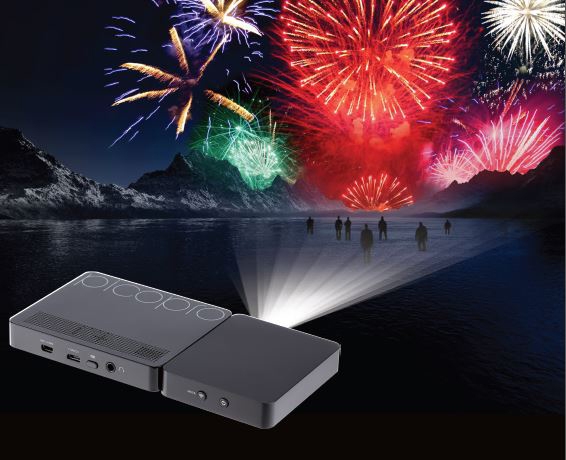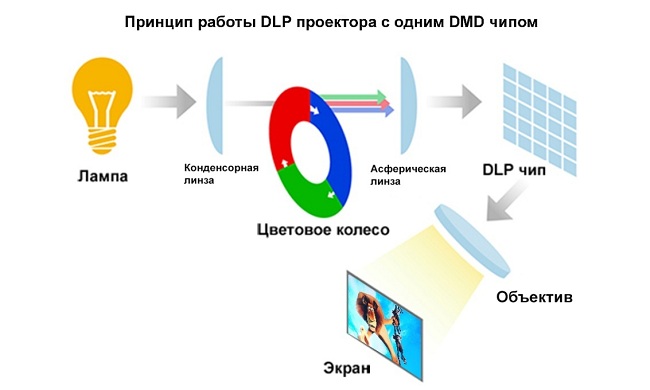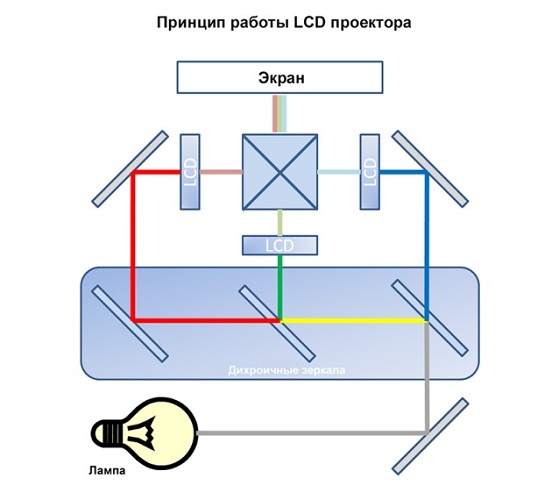Compare technology DLP and LCD projectors
Multimedia projectors help to output graphic and video information from various sources to the big screen. They are widely used not only in educational institutions, but also in business. The market for interactive multimedia devices is huge. Each technology that manufacturers use has its own advantages and features. Consider which digital equipment is preferable for different applications - LCD or DLP projector, their advantages and disadvantages.
Content
Projection technology
Depending on the projector, the image quality is different. The resulting picture can be estimated by main parameters:
- brightness,
- color accuracy,
- contrast,
- color depth
- update frequency,
- lighting uniformity
- optical efficiency
- resolution.

In order for multimedia images to look high-quality, projector technologies must ensure a high level of key parameters. However, not all projection systems can equally provide the optimal technical level.
Next, we consider the main distinctive features of LCD and DLP digital technologies.
DLP technology features
DLP technology (translated from English as “digital light processing”) is the most promising technical solution, which is based on the invention of the American scientist L. Hornbek, digital micromirror device.
The device matrix consists of several thousand mirrors with dimensions of not more than 16 microns. One detail corresponds to 1 pixel and is made of an aluminum alloy. Due to the features of the mirror surface, the material has a high reflectivity. The elements of micromirrors with the help of the axis attached to the bracket. It joins the base of the matrix with a special system of highly mobile plates. Thus, the mirrors are placed on top integrated circuit.
Under the micromirrors in 2 opposite corners are electrodes, which are connected to a static Sram memory. Due to the action of the electric field, microscopic mirrors take two positions, while deviating clearly from the central axis to the right or left by 10 degrees. As a result, reflected from the lcd-matrix, the light is focused using the optical system of the micromirror and positioned on the display.

The principle of the DLP projector
DLP technology allows you to create a digital DLP projector with a high degree of brightness. Such digital devices use a complex structure consisting of three microcircuits.
The principle of the technology:
- the white beam of light is split by a prism into 3 components - red, blue and green;
- the light fluxes are redirected clearly to their separate chip surface;
- colored rays reflected from the mirrors are focused on the screen using a projection lens.
For broadcasting in cinemas widescreen images are most often used these devices.
DLP projector uses digital technology, where the pixels are binary elements that are in two positions: on or off.Due to this, there is no sensitivity of gray color to various environmental factors and is provided high degree of repeatability. Due to this feature gradation of brightness, color shades are projected stably and evenly over the entire area.
Features of LCD technology
When using LCD technology, multimedia projectors are equipped with 3 polysilicon lcd screens. Each of the panels is responsible for its color. Matrices consist of a collection of individual pixels. Between them are placed control components that regulate their transparency. Next, the beams of color through the prism are combined, and thanks to the connecting lenses are projected on the monitor screen.
New 3LCD digital projectors have improved specifications. Three-matrix products use Texas Instruments brand chips. The distinctive characteristics of the products of the 3LCD Group - due to the projection of three colors of the spectrum onto the display, a bright color space is obtained, there is no “rainbow effect”, the transmission of gray shades is as close to reality as possible.
Projectors using digital LCD technology, work on this principle:
- white light of a lamp at the expense of 2 dichroic micromirrors is split into primary colors: green, red and blue;
- then each color is passed through the LCD-matrix;
- a full color image is formed.

Comparative characteristics of DLP or LCD projectors
Recently, both technologies have evolved and improved, so the differences between them are becoming less noticeable. The table contains the main pros and cons of the two systems.
| DLPprojectors
|
LCDprojectors
|
|
| Benefits | high degree of interchangeability of equipment;
optimum optical efficiency; color accuracy; brightness gradation is uniform over the entire plane of the surface; equipment reliability; the ability to carry out 3D projection on widescreen screens; high contrast ratio; light weight equipment; suitable for use in rooms with dusty and smoky conditions |
saturated colors of the picture;
low energy consumption; high degree of brightness |
| disadvantages | "Rainbow effect" that occurs on the projected display | it is necessary to periodically clean and replace the filter;
less contrast; pixel visibility; reduced image quality after operation; equipment is heavier and heavier |
Despite the existence of small flaws, both technologies are constantly improving, and the lineup is updated periodically. Manufacturers of digital projectors are modifying devices to improve the quality of images.
Conclusion
Choosing which digital devices will be more suitable for business and satisfy the expectations of the audience - DLP or LCD digital projectors, take into account the operational parameters, reliability and functionality of the system.
A projector with DLP technology will be suitable for reproducing an image on a widescreen screen in a movie theater, broadcasting videos and presentations. For home viewing DLP projector is also more suitable. It has high characteristics of chromaticity, contrast, image stability. Digital portable DLP devices have proven to be reliable and high-quality modern projection devices. For broadcast with accurate color and for economical use of electricity choose LCD projectors.

/rating_on.png)
/rating_off.png)











